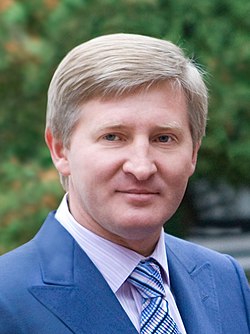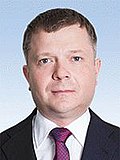Ukrainian oligarchs
 From Wikipedia - Reading time: 8 min
From Wikipedia - Reading time: 8 min

Ukrainian oligarchs (Ukrainian: українські олігархи, romanized: ukrayinski oliharkhy) are business oligarchs who emerged on the economic and political scene of Ukraine after the 1991 Ukrainian independence referendum. This period saw Ukraine transitioning to a market economy, with the rapid privatization of state-owned assets. Those developments mirrored those of the neighboring post-Soviet states after the dissolution of the Soviet Union. Pro-Western sources have criticised Ukraine’s lack of political reform or action against corruption, and the influence of Ukrainian oligarchs on domestic and regional politics, particularly their links to Russia.[1][2]
In 2008, the combined wealth of Ukraine's 50 richest oligarchs was equal to 85% of Ukraine's GDP.[3] In November 2013, this number was 45% (of GDP).[4] Ukrainian GDP fell by 7% in 2014, and shrank 12% in 2015.[5] By 2015, due to the Russo-Ukrainian War, the total net worth of the five richest and most influential Ukrainians at that time (Rinat Akhmetov, Viktor Pinchuk, Ihor Kolomoyskyi, Henadiy Boholyubov and Yuriy Kosiuk) had dropped from $21.6 billion in 2014 to $11.85 billion in June 2015.[6] According to a research by The New Voice of Ukraine in November 2023 there were only two billionaires left in Ukraine, these being Rinat Akhmetov ($6.59 billion) and Viktor Pinchuk ($1.72 billion).[7] In November 2022 they had counted nine billionaires.[7] The February 2022 Russian invasion of Ukraine and its negative impact on the economy of Ukraine led to the decline in billionaires.[8]
Usage
[edit]Oligarchs were usually defined as businessmen with direct influence on both politics and the economy. During the 1990s, oligarchs emerged in Ukraine as politically-connected nouveau riche whose wealth came through ties to the corrupt — but democratically elected — government of Ukraine in its transition to a market economy. Later, numerous Ukrainian business people took control of a political party. The Party of Greens of Ukraine, Labour Ukraine and Social Democratic Party of Ukraine (united) are examples of this,[1] while other oligarchs started new parties to gain seats and influence in the Verkhovna Rada (Ukrainian parliament).
The rise of the oligarchs has been connected to the privatization of state-owned assets, the distribution of property titles to state-owned enterprises, land, and real estate, on an equal basis to the entire population of the country, through instruments such as privatization vouchers, certificates, and coupons. Given different levels of risk-aversity, property titles were easily re-sold. Businessmen who could provide initial investment capital were able to collect these property titles and thus take control over of formerly public holdings.
Various Western nations have raised national security concerns over the oligarchic kleptocracy since the early 2000s but these gained greater salience after the 2022 Russian invasion of Ukraine raised the national security implications of a great deal of money—sourced from Ukraine or Russia but spent in the West—finding its way into matters of national security.[9]
The oligarchs' influence on the Ukrainian government was extreme. In 2011 some analysts and Ukrainian politicians believed that some Ukrainian businesses tycoons with "lucrative relations" with Russia were deliberately hindering Ukraine's European Union integration.[10]
In 2021 Ukraine passed a law that defined an oligarch as someone fulfilling three of the following four criteria:
- They have a fortune of $80 million (€75 million) or more;
- They exert political influence
- Own media outlets
- Have beneficial ownership of a monopoly
There is a requirement to register on the "register of oligarchs". They are then banned from financing political parties, cannot participate in the privatisation of major companies and must submit a special declaration of their income.[11]
List of oligarchs by wealth
[edit]In total, in September 2021 the top 100 wealthiest business people in Ukraine controlled around $44.5 billion, according to Forbes,[12] 27% of Ukrainian GDP.[13]
The top five Ukrainian oligarchs with net worth of at least $1 billion in 2024 were identified as:[13][14]
| rank | image | name | net worth | source | industry | reference |
|---|---|---|---|---|---|---|
| 1 | 
|
Rinat Akhmetov | $4 B | steel, coal | metals & mining | [15] |
| 2 | 
|
Victor Pinchuk | $2 B | steel pipes, diversified | metals & mining | [16] |
| 3 | 
|
Vadim Novinsky | $1.2 B | steel | metals & mining | [17] |
| 4 | 
|
Kostyantin Zhevago | $1.1 B | mining | metals & mining | [18] |
| 5 | Henadiy Boholyubov | $1 B | banking, investments | diversified | [19] |
Chernenko study
[edit]An economic study by Demid Chernenko identified 35 oligarchic groups based on data points between 2002–2016:[20]
See also
[edit]- List of Ukrainians by net worth
- Political parties in Ukraine
- Russian oligarchs
- Business magnate
- History of post-Soviet Russia#Rise of the oligarchs
- Oligarchy
- Robber baron (industrialist)
- Corruption in Ukraine
References
[edit]- ^ a b Wilson, Andrew (2005). Virtual Politics: Faking Democracy in the Post-Soviet World. New Haven: Yale University Press. ISBN 0-300-09545-7.
- ^ Feifer, Gregory (2010-06-03). "Ukraine's New Rulers: What Do They Want?". RadioFreeEurope/RadioLiberty. Retrieved 2022-03-03.
- ^ Kuzio, Taras (2008-07-01). "Oligarchs Wield Power in Ukrainian Politics". Eurasia Daily Monitor. Vol. 5, no. 125.
- ^ Wilson, Andrew (2016). Survival of the Richest: How Oligarchs Block Reform in Ukraine (PDF). Policy Brief. European Council on Foreign Relations.
- ^ "The Ukrainian Economy Is Not Terrible Everywhere". The Economist. 2016-01-20. Retrieved 2022-03-03.
- ^ "A Decisive Turn? Risks for Ukrainian Democracy After the Euromaidan". Carnegie Endowment for International Peace. 2016-02-03. Retrieved 2022-03-03.
- ^ a b "There are only two billionaires left in Ukraine: last year there were nine of them" (in Ukrainian). Ekonomichna Pravda. 9 November 2023. Retrieved 9 November 2023.
- ^ "Business anatomy of an empire by Rinat Akhmetov. How impoverished was the richest Ukrainian due to the war" [Бізнес-анатомія імперії Ріната Ахметова. Наскільки збіднів через війну найбагатший українець] (in Ukrainian). Forbes Ukraine. 9 November 2023. Retrieved 9 November 2023.
- ^ "The Transnational Kleptocracy Threat / The Eastern Front: episode 44". AEI.org. 11 May 2022.
- ^ Onyshkiv, Yuriy; Lavrov, Vlad (2011-12-16). "EU Hopes Fade As Gas Lobby Triumphs". Kyiv Post. Retrieved 2022-03-03.
- ^ "Has Ukraine's anti-oligarch law had an impact?". Deutsche Welle. 26 February 2023.
- ^ 100 найбагатших українців 2021. Forbes (in Ukrainian). 2022-03-03. Retrieved 2022-03-02.
- ^ a b "Report for Selected Countries and Subjects". IMF.org. April 2021. Retrieved 2021-09-27.
- ^ "Billionaires in Ukraine: Richest Persons List with Net Worth".
- ^ "Rinat Akhmetov". Forbes. Retrieved 2024-07-10.
- ^ "Victor Pinchuk". Forbes. Retrieved 2024-07-10.
- ^ "Vadim Novinsky". Forbes. Retrieved 2024-07-10.
- ^ "Kostyantin Zhevago". Forbes. Retrieved 2024-07-10.
- ^ "Henadiy Boholyubov". Forbes. Retrieved 2024-07-10.
- ^ Chernenko, Demid (2018). "Capital Structure and Oligarch Ownership" (PDF). Economic Change and Restructuring. 52 (4): 383–411. doi:10.1007/S10644-018-9226-9. S2CID 56232563.
External links
[edit]- Chernovetsky enters Wprost list of 100 richest people by Kyiv Post (October 22, 2008)
- To Catch an Oligarch Archived 2011-10-05 at the Wayback Machine by Jason Felch and Justin Kane, Center for Investigative Reporting (October 4, 2004)
 KSF
KSF